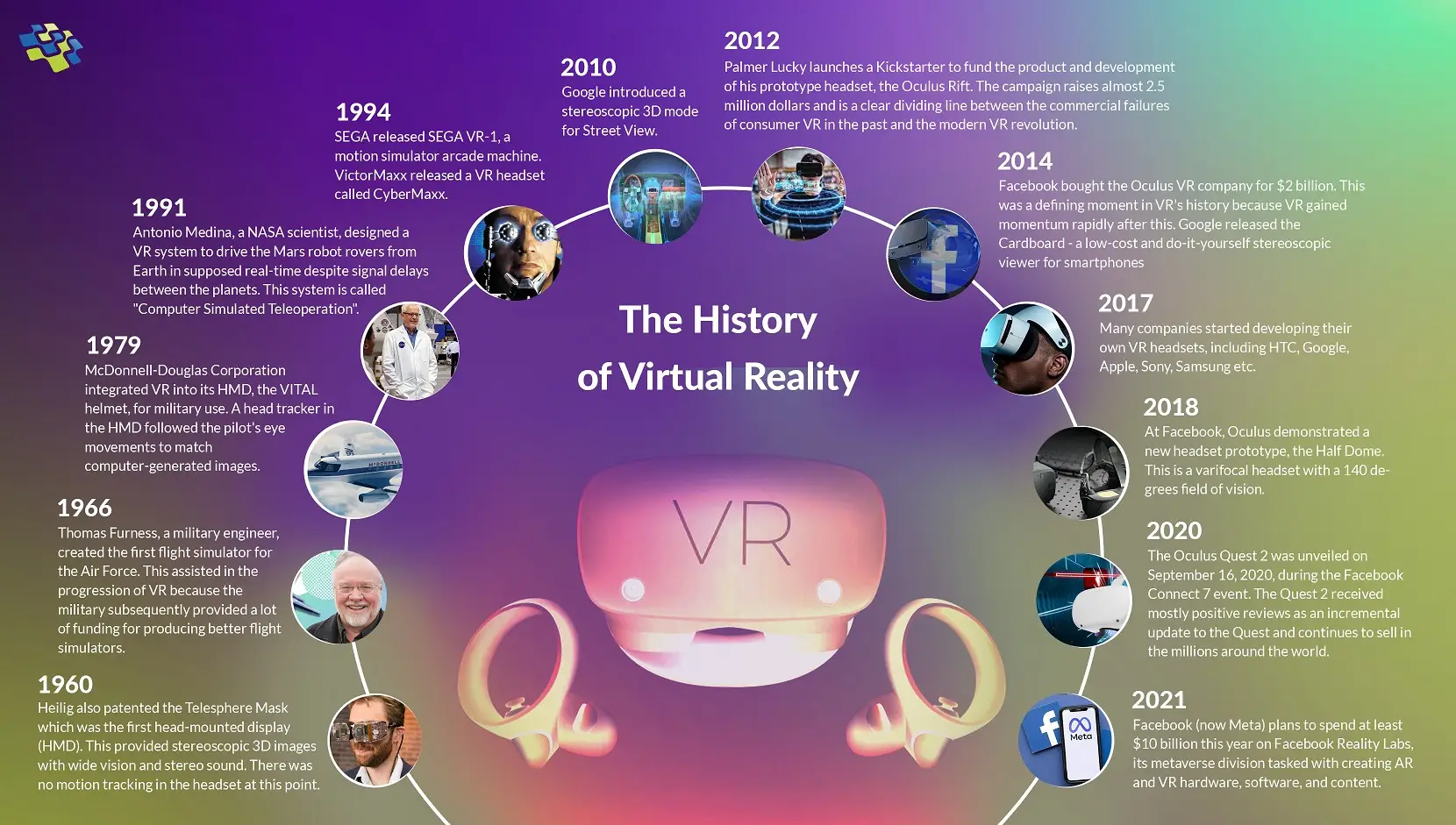Virtual Reality (VR) is a technology that generates a virtual environment, enabling users to engage and experience a digital world that closely resembles a real-world setting. To immerse themselves in the virtual world, users usually wear a headset that projects a 3D image, along with other peripherals like gloves or controllers that enable interaction with the virtual environment. Since its creation in the 1960s, Virtual Reality (VR) has undergone significant development, evolving from basic flight simulators to contemporary VR headsets, and has come a long way.
The Early Years of VR
In 1960, The Telesphere Mask, patented by Morton Heilig, became the first head-mounted display (HMD). At the time of its release, the Telesphere Mask offered a broad field of vision, stereo sound, and stereoscopic 3D images, but lacked motion tracking capabilities within the headset. Heilig believed that the Telesphere Mask would be used for a variety of applications, including education, entertainment, and even psychotherapy.
In 1966, the inaugural flight simulator for the Air Force was designed by Thomas Furness, a military engineer. Funding from the military to produce improved flight simulators played a crucial role in advancing VR technology.. The flight simulator included a head-mounted display (HMD) with a mounted camera that would track the pilot’s head movements, providing a more immersive experience.
In 1979, McDonnell-Douglas Corporation integrated VR into its VITAL helmet, an HMD designed for military use. The helmet included a head tracker that followed the pilot’s eye movements, aligning computer-generated images with the pilot’s view. The VITAL helmet was also used for training military pilots, which helped to improve the accuracy and efficiency of their missions.
The Rise of Consumer Virtual Reality
The 1990s saw the rise of consumer VR, with several companies introducing Virtual Reality products for home use. Here are some key developments during this time:
• 1991: Antonio Medina, a NASA scientist, designed a Virtual System system called “Computer Simulated Teleoperation” to drive Mars robot rovers from Earth in supposed real-time despite signal delays between the planets. This technology has since been used for other space exploration missions.
• 1994: SEGA launched the SEGA VR-1, an arcade machine with motion simulators, while VictorMaxx introduced a VR headset known as CyberMaxx. The CyberMaxx had a 320×200 pixel display and was compatible with Sega Genesis and Super Nintendo gaming systems.
• 1995: Nintendo released the Virtual Boy, a 3D gaming console that used a red LED display. However, due to its high price, lack of quality games, and issues with causing headaches and eye strain, it was a commercial failure.
While these early consumer VR products were not successful, they set the stage for future developments.
The Modern Era of Virtual Reality
In the 2010s, VR technology experienced a resurgence, with significant advancements made in hardware and software. Here are some notable developments during this time:
• 2010: Google introduced a stereoscopic 3D mode for Street View, allowing users to explore locations in 3D using a Google Cardboard viewer.
• 2012: Palmer Lucky initiated a Kickstarter campaign to gather funds for the development of his prototype VR headset, the Oculus Rift. The fundraising effort garnered nearly 2.5 million dollars and served as a stark contrast between the unsuccessful attempts at consumer VR in previous years and the current VR revolution.
• 2014: The acquisition of Oculus VR by Facebook for $2 billion marked a significant milestone in the history of VR. Google introduced the Cardboard, an affordable and self-assembled stereoscopic viewer designed for use with smartphones.
• 2016: HTC released the Vive, a high-end VR headset that included motion controllers and room-scale tracking, allowing users to move around in a virtual space. The Vive was well-received and helped to cement VR’s place in the gaming industry.
• 2017: many companies started developing their own VR headsets, including HTC, Google, Apple, Sony, Samsung, etc.
• 2018: At Facebook’s Oculus Connect conference, Oculus VR demonstrated a new headset prototype, the Half Dome, which is a varifocal headset with a 140-degree field of vision. This technology allowed for more natural eye movement and focus within virtual environments.
• 2020: The Oculus Quest 2 was introduced and received mainly favorable reviews as an incremental improvement over its predecessor, the Quest. It has since then continued to be a popular seller, with millions of units sold globally• 2021: Meta (formerly Facebook) committed to investing a minimum of $10 billion into Facebook Reality Labs, the company’s metaverse unit, which is responsible for developing AR and VR hardware, software, and content.
Further Read: AI Enablement & Automation
The Future of Virtual Reality
The future of VR appears promising and brimming with potential, especially with large companies such as Facebook investing billions of dollars in its development. Meta, formerly known as Facebook, plans to allocate no less than $10 billion to Facebook Reality Labs, its metaverse division that focuses on creating AR and VR software, hardware, and content.
One area where VR technology is already being used to great effect is in education. VR is an excellent tool for providing students with immersive and interactive learning experiences that can help them better understand complex concepts. For example, medical students can use VR simulations to practice surgeries without the need for real patients, reducing the risk of mistakes.
VR is also being used in healthcare to help treat and manage a variety of conditions. For example, VR can be used to treat patients with phobias, anxiety, and PTSD by providing them with a safe environment in which to confront their fears.
Entertainment is another area where VR is having a significant impact. VR gaming is already a popular pastime, and the continued development of VR technology will only lead to even more immersive and realistic gaming experiences.
Socialization is yet another area where VR is showing great potential. VR technology allows people to interact with each other in virtual environments, providing a sense of presence and connection that is not possible through traditional video conferencing tools.
Conclusion
Virtual Reality has come a long way since its inception in the 1960s. From early flight simulators to modern VR headsets, VR technology has evolved significantly over the years. With the rise of consumer VR, the future of this technology is full of exciting possibilities.
Advancements in VR technology are making it more accessible and affordable to the masses, and it is finding its way into many different areas of our lives, including education, healthcare, entertainment, and socialization.
As Virtual Reality technology continues to evolve and improve, we can expect even more innovative and exciting applications to emerge. With companies like Facebook investing heavily in its development, the potential of VR technology is truly limitless.
Stay In the Know
Get Latest updates and industry insights every month.

